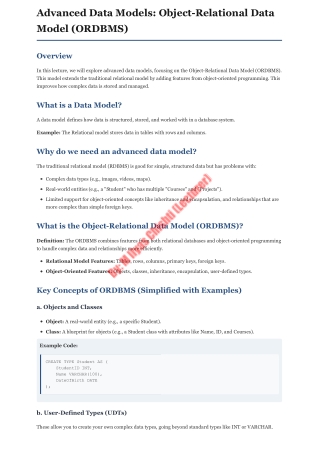
0 likes | 1 Views
Explore the hybrid world of Object-Relational Databases (ORDBMS). This lecture covers the essential features that extend the relational modelu2014including User-Defined Types, inheritance, and encapsulationu2014to handle complex data structures. Learn the key differences between RDBMS and ORDBMS, identify ideal use cases (e.g., GIS, Multimedia), and understand the practical trade-offs of using this advanced data model.

E N D
Advanced Data Models: Object-Relational Data Model (ORDBMS) Overview In this lecture, we will explore advanced data models, focusing on the Object-Relational Data Model (ORDBMS). This model extends the traditional relational model by adding features from object-oriented programming. This improves how complex data is stored and managed. What is a Data Model? A data model defines how data is structured, stored, and worked with in a database system. Example: The Relational model stores data in tables with rows and columns. Why do we need an advanced data model? The traditional relational model (RDBMS) is good for simple, structured data but has problems with: Complex data types (e.g., images, videos, maps). Real-world entities (e.g., a "Student" who has multiple "Courses" and "Projects"). Limited support for object-oriented concepts like inheritance and encapsulation, and relationships that are more complex than simple foreign keys. What is the Object-Relational Data Model (ORDBMS)? Definition: The ORDBMS combines features from both relational databases and object-oriented programming to handle complex data and relationships more efficiently. Relational Model Features: Tables, rows, columns, primary keys, foreign keys. Object-Oriented Features: Objects, classes, inheritance, encapsulation, user-defined types. Key Concepts of ORDBMS (Simplified with Examples) a. Objects and Classes Object: A real-world entity (e.g., a specific Student). Class: A blueprint for objects (e.g., a Student class with attributes like Name, ID, and Courses). Example Code: CREATE TYPE Student AS ( StudentID INT, Name VARCHAR(100), DateOfBirth DATE ); b. User-Defined Types (UDTs) These allow you to create your own complex data types, going beyond standard types like INT or VARCHAR.
Example: A custom type for an address. CREATE TYPE Address AS ( Street VARCHAR(100), City VARCHAR(50), Zipcode INT ); c. Inheritance (Extending Types) This is similar to sub-classing in object-oriented programming. A new type can inherit all the features of an existing type. Example: A Graduate Student type that inherits from the Student type and adds a new attribute. CREATE TYPE GraduateStudent UNDER Student ( ThesisTopic VARCHAR(100) ); d. Encapsulation Data and the methods (functions) that operate on that data can be bundled together. Example: Defining a method to calculate a student's age from their date of birth. CREATE FUNCTION CalculateAge(DateOfBirth DATE) RETURNS INT AS $$ SELECT EXTRACT(YEAR FROM AGE(DateOfBirth)) $$ LANGUAGE SQL; e. Complex Data Types (Nested Structures) ORDBMS can store data within data (nested structures). Example: A student can have multiple phone numbers stored directly with their record. CREATE TABLE Student ( StudentID INT, Name VARCHAR(100), Phones TEXT[] -- This is an array of text ); f. Collections (Arrays and Sets) Arrays, lists, and sets can be stored as attributes of a table. Example: A student can be enrolled in multiple courses, stored as a list. CREATE TABLE Student ( StudentID INT, Name VARCHAR(100), Courses TEXT[] -- This is an array of course names );
Object-Relational vs. Relational Database: Key Differences Features Relational DB (RDBMS) Object-Relational DB (ORDBMS) Complex types (User-Defined Types, nested types) Data Types Simple types (int, varchar) Relationships Foreign keys Objects and references Extensibility Limited Highly extensible with User-Defined Types Performance Optimized for structured data Optimized for complex data MySQL, PostgreSQL (default mode) Examples PostgreSQL (extended mode), Oracle Benefits of ORDBMS Supports Complex Data: Handles multimedia, maps, and hierarchical data well. Code Reusability: You can reuse object definitions and methods. Better Data Integrity: Data is stored in a way that is closer to how it appears in the real world. Use Cases of ORDBMS Multimedia Databases: Storing videos, audio, and images. Geographical Information Systems (GIS): For managing maps and location-based data. Scientific Data Management: Handling complex data from experiments. E-commerce: Managing product catalogs where products have many different types of attributes. Limitations of ORDBMS Complexity: It is more difficult to learn than traditional relational models. Performance: Can be slower for simple datasets because of the extra features and overhead. Limited Adoption: Not all databases fully support ORDBMS features. ORDBMS in Real-World Databases PostgreSQL: One of the most popular ORDBMS. Oracle Database: Provides advanced object-relational capabilities. IBM Db2: Includes ORDBMS features for handling complex data. Summary of Key Takeaways ORDBMS blends relational and object-oriented features to handle complex data. Key features include user-defined types, inheritance, encapsulation, and complex data structures. ORDBMS is useful in specialized domains like multimedia, GIS, and scientific research.